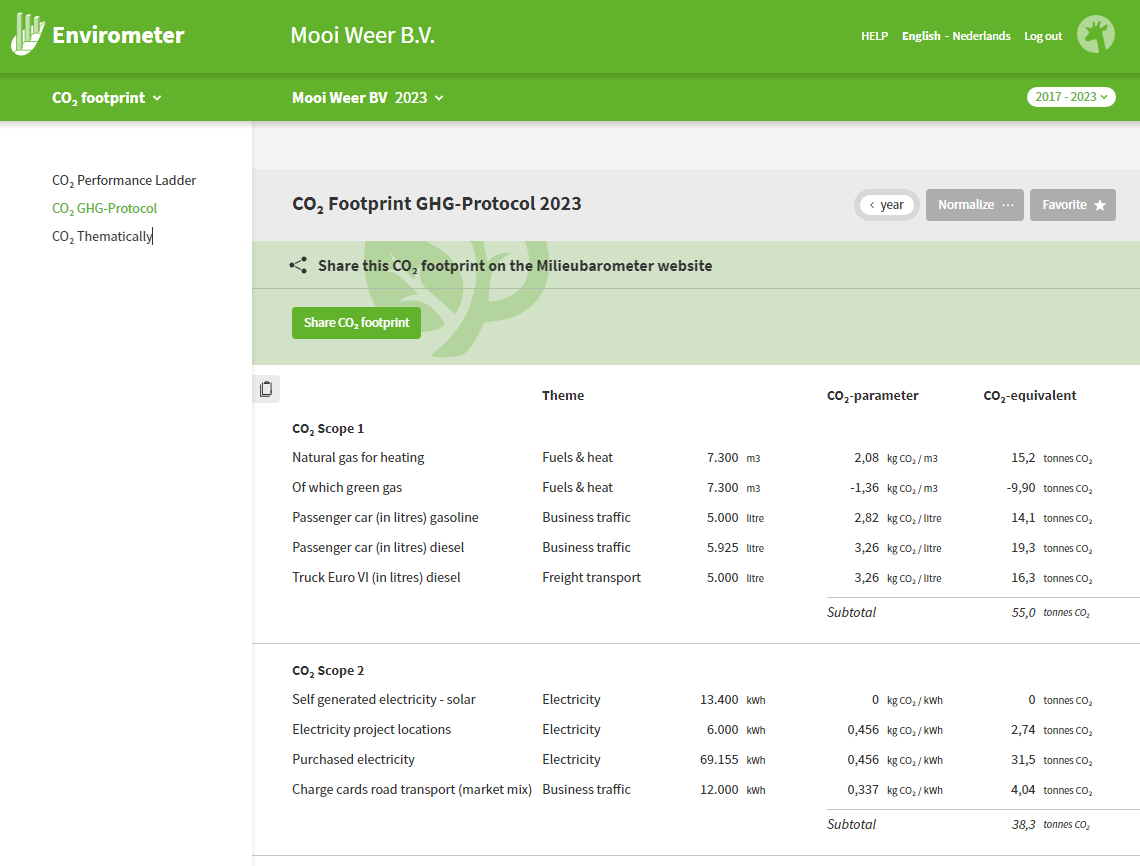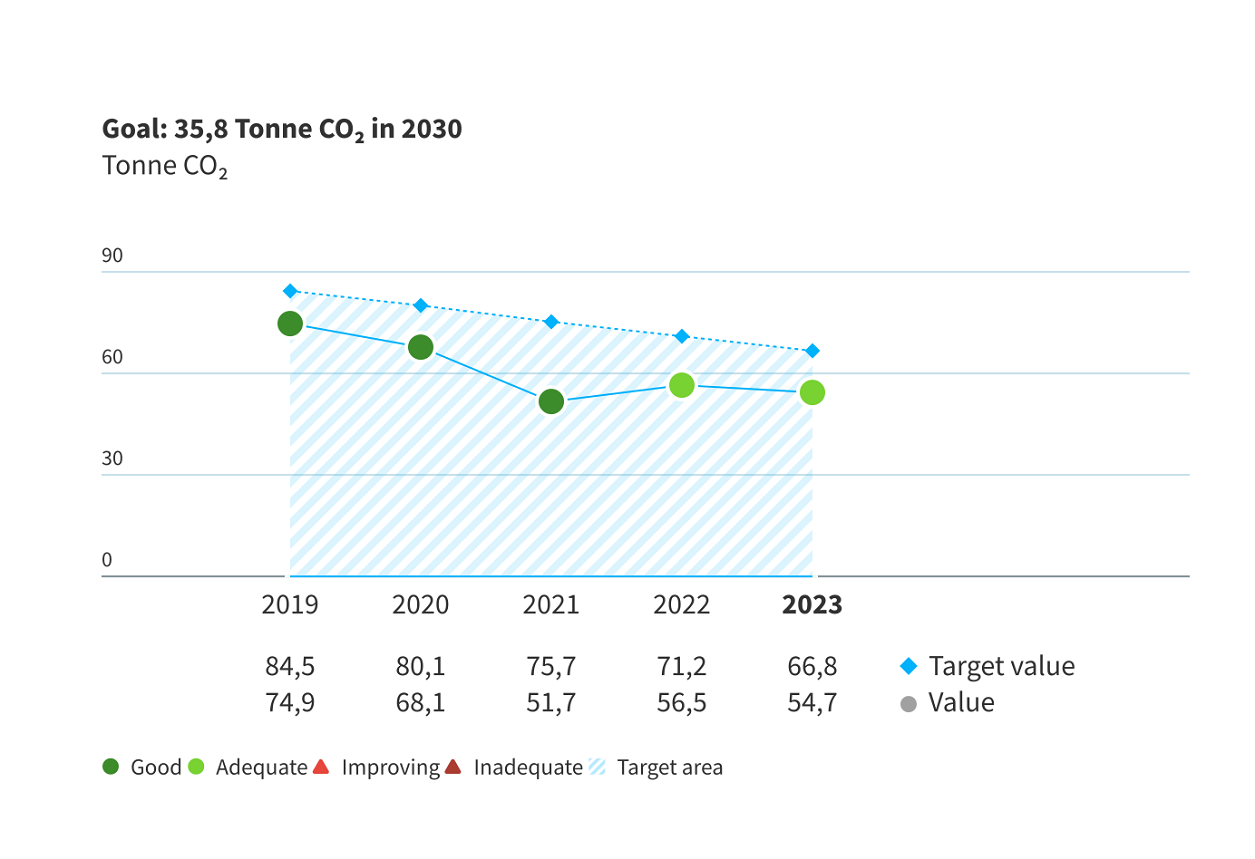Corporate Sustainability Reporting Directive (CSRD)
Calculate the emissions included under mandatory sustainability reporting for larger companies.
The Corporate Sustainability Reporting Directive (CSRD) is new EU legislation that requires larger companies to report in accordance with the European Sustainability Reporting Standards (ESRS) from the 2024 or 2025 financial year (see the explanation at the bottom of this page).
The Envirometer helps you measure and report your emissions for the topic of climate change. You can, of course, calculate your emissions in Excel; however, a carbon footprinting tool like Envirometer offers many advantages. It often takes considerable time for a company to get a complete picture of their emissions, which is why it is advisable to start on carbon footprinting right away.
The Envirometer can help you meet ESRS E1-6 (gross Scope 1, 2 and 3 emissions) and part of reporting requirement E1-4 ‘Targets related to climate change mitigation and adaptation’:
- Calculate and classify your emissions by scope (Scopes 1, 2 and 3) according to the international, ESRS-integrated Greenhouse Gas Protocol (GHG Protocol).
- Set climate targets.
- Report annually on your progress towards achieving your emission reduction targets.
Calculator for Scope 1, 2 and 3 emissions
When you enter your data into the Envirometer, your GHG emissions are automatically calculated and sorted into Scopes 1, 2 and 3. For standard activities, for example the use of diesel for transport, the Envirometer automatically applies the associated emission factors.
For business-specific emission calculations (for the use of raw materials for example) you enter the corresponding emission factor yourself. You can request these emission factors from your supplier or service provider.
These are the steps you need to take:
- Enter your energy and transport data in the Envirometer.
- View the results in your emission table and data visuals.
Generate your carbon footprint table

Once you have entered all your energy data, the carbon footprint is displayed according to the scope classification used by the GHG Protocol.
Gradually expand the scope of your carbon footprinting
It often takes some time to get a complete picture of GHG emissions, so we recommend that you start collecting energy and transport data from your company right away while also gathering information about emission-relevant activities in your supply chain(s). Your supply chain emissions (Scope 3 emissions) do not have to be completely quantified in the first year of reporting, though companies must report what steps they are taking to identify and quantify these emissions in the following years.
Setting climate targets
The CSRD requires companies to report on their targets for cutting GHG emissions (climate change mitigation) and other topics relevant to the company, such as energy efficiency. An example is a target of cutting emissions by 50% by 2030 compared to the base year 2018. You then evaluate annually whether your emissions are moving in the right direction.
Though not a requirement in the CSRD, the data visuals generated by the Envirometer showing a company’s GHG emissions and its progress towards reaching its reduction targets are also a great way to make data more accessible and understandable.

The Envirometer displays your reduction target in a ‘goal-line chart’; your score compared to the target (goal line) will appear for every year you enter your energy data.
Publish your results annually
In addition to the disclosures companies are required to include in their management report in line with the CSRD, many companies also communicate about their carbon footprint in other public reports and on their website.
The Envirometer offers several options to publish your progress:
- You can download individual data visuals (in PDF, PNG or HTML) to include in your report or on your webpages.
- You can download a PDF report with a selection of data visuals.
- You can publish your emissions in the list of published carbon footprints
Suppliers of companies subject to the CSRD also get asked about their carbon footprint.
It is expected that companies subject to CSRD will increasingly ask their suppliers to provide figures so that they can better understand their supply-chain emissions. For this reason, to prepare for this it may be a good idea for companies and organisations not subject to CSRD to start registering emissions in the Envirometer as well.
About the CSRD and who is subject to this
New EU legislation has come into effect requiring all large and all listed companies to report on sustainability from financial year 2024 (first group) or 2025 (second group). This is set out in the Corporate Sustainability Reporting Directive (CSRD). The first-phase companies are those that already have to report on Environment, Social and Governance (ESG) matters at EU level under the Non-Financial Reporting Directive (NFDR). The second group concerns companies that meet two of the following three criteria:
- more than 250 employees (averaged over a year)
- net turnover of more than €50 million per year
- balance sheet total of more than €25 million
It is possible that large organisations in the Netherlands (that are not a ‘B.V.’ or ‘N.V.’) will also have to comply; the Dutch government is still deciding on this.
The CSRD requires companies to report on ESG matters in their management report in accordance with uniform requirements. The ESG report and the supporting documentation for the figures are checked by an auditor and the figures are made publicly available in a database.
Get started with the Envirometer
Want to get started immediately? No problem! Take out a subscription today and get started by filling in your details.

Frequently asked questions
Looking for an answer and your question is not listed? Then take a look at our FAQ overviewpage
-
Is the Envirometer usable internationally?
-
The Envirometer is definitely usable internationally as an environmental monitoring and CO₂ footprint tool. It is used by multinationals for their locations in the Netherlands as well as for locations in Europe and the rest of the world.
The Envirometer is fully bilingual in English and Dutch. A user can switch languages at any time, and the reports are available in English.
The environmental and CO₂ factors are originally Dutch, but the CO₂ factors can be adjusted for locations abroad.
-
How can we prepare as an organization for the CSRD?
-
At the end of July 2023, the reporting requirements were announced in the form of the ESRS (European Sustainability Reporting Standard). Companies that report based on GRI (Global Reporting Initiative) already have a solid foundation for the ESRS, although they will still often face significant challenges to meet this standard. It is advisable for all companies to start preparing now in order to be able to add an ESG report to the management report by early 2026.
Learn more about all aspects of the CSRD on the website of the Social and Economic Council (SER).